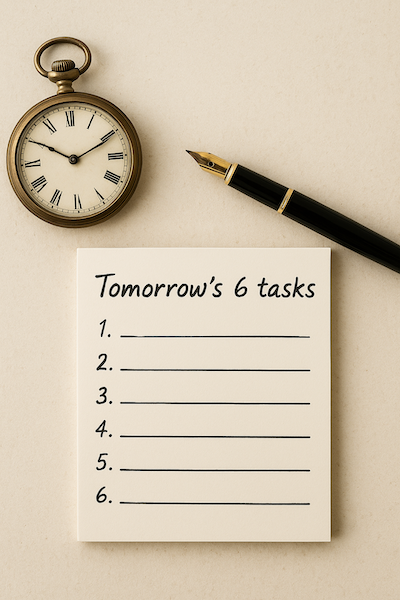Hey there! I’m on the lookout for my next engineering leadership adventure. If you know of any roles let me know through my contact page or on LinkedIn.
The Ivy Lee Method: A 100-Year-Old Productivity Hack That Still Works

This idea isn’t original. In fact it’s over 100 years old. It’s a productivity method created by a man named Ivy Lee when he was asked by Charles M. Schwab to help him “increase the efficiency of his team and discover better ways to get things done.” (The Ivy Lee Method - James Clear)
What it is
The Ivy Lee Method can be summarized like this:
- At the end of each workday, write down the most important tasks you need to complete the next day (no more than six).
- Prioritize those tasks in order of importance.
- The next day, start with the first task and work on it until it’s finished before moving to the next.
- Continue down the list, moving on only after completing each task.
- At the end of the day, move any unfinished tasks to the next day’s list.
- Repeat daily.
Why it works:
- It allows you to focus on what matters most and ignore everything else
- It keeps your to-do list manageable (no more than six tasks)
- It gives you something to look forward to, because you know exactly what to work on the next day
- It builds daily momentum through clarity and discipline
How to use it
Until recently, my mistake in using this method was failing to clearly define my goals and making sure they were achievable. This led to ambiguous tasks that never seemed to end, and a list of tasks that kept growing. The solution was to start making SMART goals.
SMART is a framework for setting clear, actionable goals. Each goal should be:
- Specific: Clearly defined, focused, and unambiguous
- Measurable: Quantifiable so progress can be tracked
- Achievable: Realistic and attainable given resources and constraints
- Relevant: Aligned with broader objectives and meaningful to you
- Time-bound: Has a clear deadline or time frame
Another surprisingly effective habit is visualizing myself working on the next day’s tasks. For whatever reason, going through the tasks in my head during the course of the evening helps me look forward to starting my work the following day.
Lastly, while it’s all well and good that you use this method to improve your own productivity, it’s even better to involve your team. If you’re a team lead, manager, or above, it’s a simple matter to add a Slack reminder to a channel to remind the team to set their goals for the next day. Why should you be the only one benefiting from this productivity boost?
Conclusion
When Ivy Lee suggested this method to Charles M. Schwab, he only asked that Schwab send him a check based on the value he thought it brought to his organization. “After three months, Schwab was so delighted with the progress his company had made that he called Lee into his office and wrote him a check for $25,000.” That’s the equivalent of more than $500,000 in 2025. If Charles M. Schwab found that much value in such a simple change, doesn’t it make sense that you would too?